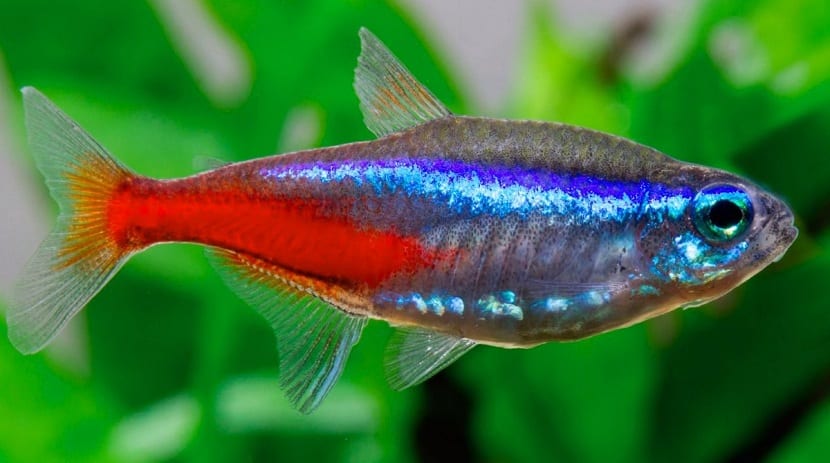
The neon fish It is one of the most demanded fish in the aquarium for its impressive color. Its scientific name is Paracheirodon innesi and it is one of the most curious fish that exist. In this article we are going to get to know this fish in depth with all its characteristics and the care it needs to keep them in good health. If you are looking to learn more about this fish to add to your tank, don't miss this post and keep reading 🙂
Do you want to know everything about the neon fish?
Key features

This fish is quite small although it is very showy. It is only about 3,5 centimeters long. Its shape is tapered. That is, it is longer than it is wide. Like many other fish, it has a forked tail and has a small adipose fin between the dorsal and tail fin.
On the sides it surprises us with its very intense and bright blue color. When the light hits it the blue color shines brightly. The color line begins at the eye and runs almost the entire surface to create a beautiful contrast between the blue and red and white the rest of the body.
Despite the fact that this fish is unique, there are people who easily mistake it for the cardinal tetra fish. Both fish share the same shades of red and blue, so it can be confusing. To differentiate them, it is necessary to realize that the red stripe of the cardinal tetra begins in the mouth and reaches the tail fin.
In the mouth of the neon fish we find very small teeth. This is because it belongs to the same family as piranhas. The innocent appearance of this fish makes us wonder what its family is.
Habitat and area of distribution
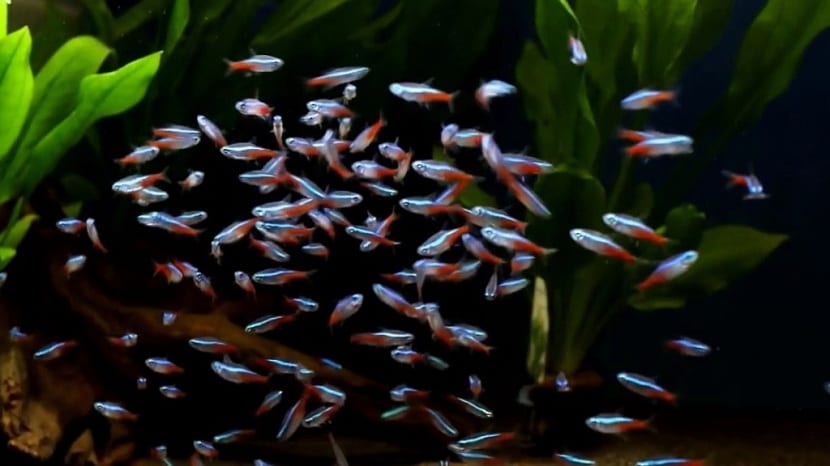
The habitat of this fish is in black waters. These types of waters are those that are quite soft and acidic. However, they can also live in clearer waters.
The distribution area is in the Amazon basin, the entire eastern zone of Peru and Colombia. In these same countries we find specimens in soft water rivers, in fresh water. They are not able to withstand even small concentrations of salt.
Its origin is Latin American, although most are purchased in stores. They are massively bred in South Asia for purchase and sale. It is more complex today to find a specimen that has been bred in Brazil, Peru or Colombia. The vast majority are bred in captivity from birth.
Food
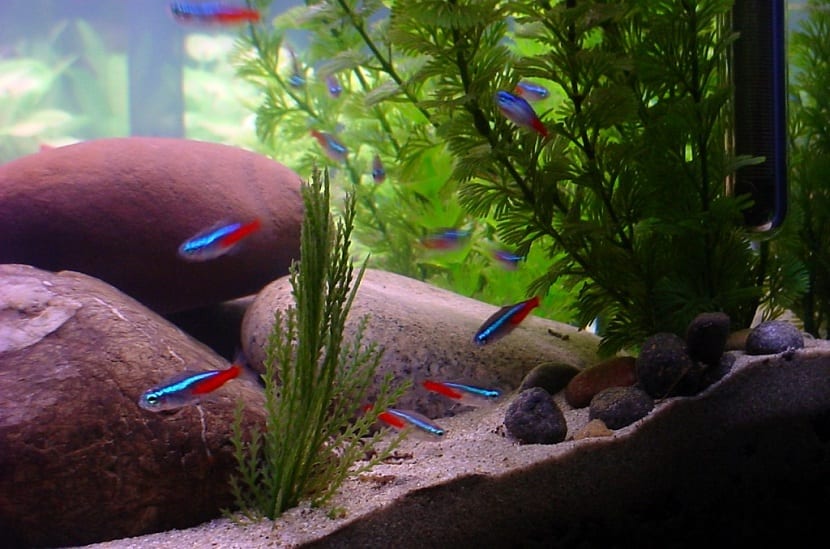
To feed the neon fish it is not necessary to give it live food. From time to time we can give him some mosquito larvae. Do not give him large food, but one that he can eat comfortably. We can also include other living species such as Artemia salina or Daphnia. Thanks to the consumption of live food, its striking colors will remain brighter.
Neon fish are omnivores, so it can also feed on plants. We can offer you some fresh vegetables from time to time. Some small lettuce or tomato chunks. It is advisable that they eat three times a day.
Reproduction
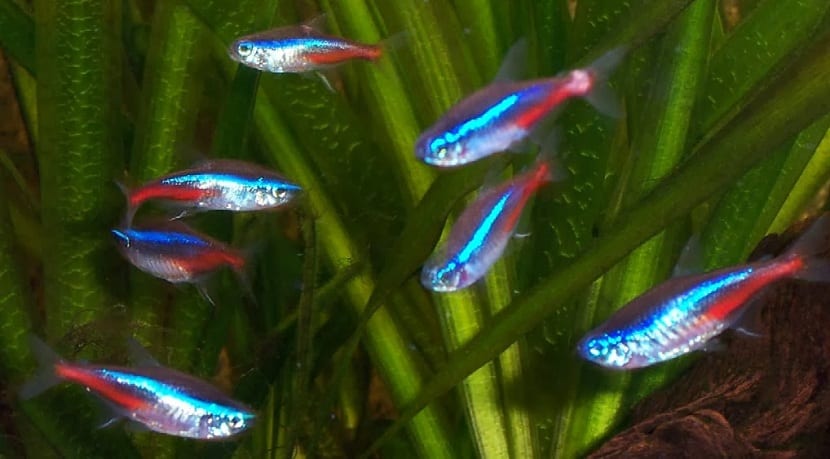
When we have the specimens in the fish tank, we must choose those that we want to reproduce. It is always advised to choose young individuals and with their sexual maturity. These fish will have the best ability to reproduce. It is important that they were born in waters with a high pH or in hard waters they will not reproduce.
To choose the females well, we must choose the most voluminous and full of eggs. Spawning it can total between 80 and 250 eggs. When this occurs, it is essential to remove the parents from the brood tank to prevent them from eating the eggs. We must separate the broodstock in a different tank so that there is no interference in spawning with the other fish in the aquarium.
For the eggs to survive, we must leave them without light. It is advisable to have an aerator that generates a small current and put some product so that the fungi do not spread. The eggs hatch after 24 hours. After a few days, the young have to be fed more so that they can develop well. In just three months we will be able to incorporate the young into the larger aquarium with the rest of the fish.
Neon fish care
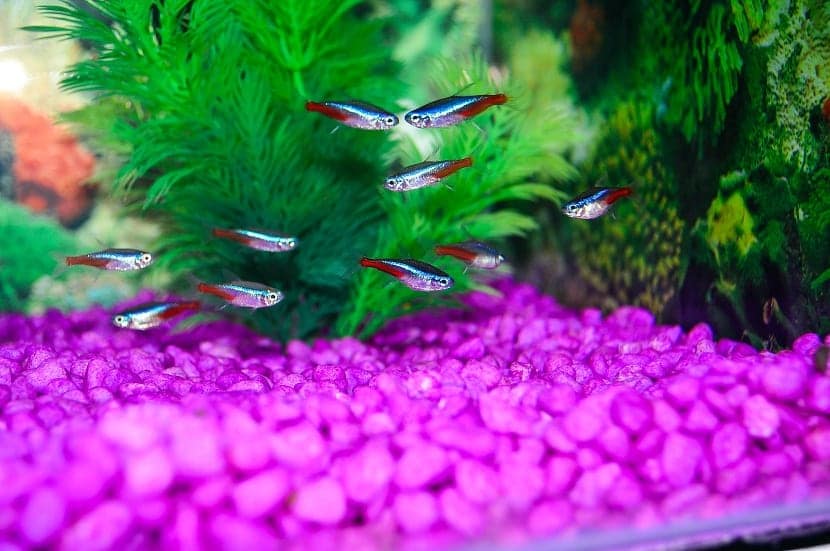
In order for our fish to live as long as possible and to develop well, we must take into account some aspects. The first thing is the temperature and quality of the water. The temperature should be between 20 and 25 degrees to mimic their natural environment from which they come. If the temperature goes out of that range it can be dangerous, since they cannot stand it easily. You need the water to be black water. That is to say, that the plants are dense and not too tall to allow light to pass through.
Since these fish are sensitive to light, it is best not to put artificial light on them. A noisy house can affect your nervous system and therefore your growth. It is important to filter the water with peat and boil it for about 10 minutes so that it does not have sodium and there is little calcium. What is very important is that the water does not have any chlorine so that it does not harm the fish.
As for the fish that the neon fish can live with, it must be taken into account that they are quite aggressive towards members of the same family. They are organized hierarchically, so our group de peces neons cannot be less than 10 fish. This hierarchical structure is necessary for the neon fish to feel that it is in optimal conditions to survive. The dominant members of the group will be surrounded by the lower-ranking individuals, which means that members of the outermost parts of the group are less protected.
The aquarium must have dimensions capable of holding about 60 liters of water. You need an empty space in the center that has no plants or decoration to get more space. We can use logs to get darkness in its waters.
Finally, for these specimens to feel that they have everything under control, it is important that the background is dark. In addition, this will contrast with the color of our fish and the aquarium will acquire greater beauty.
With this information you can learn more about this colorful fish.